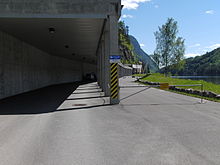코린토스의 스핀타로스
Spintharus of Corinth
코린토스의 스핀타로스(고대 그리스어: σίνραρς, 로마자: Spintharos)는 고대 그리스의 건축가이다.파우사니아스는 그리스 묘사에서 알케이마이오니드가 델포이에 [a]신전을 짓기 위해 그를 고용했다고 보고했다.이게 [1]Spintharus에 대한 유일한 기록이야.델파이의 아폴로 신전은 기원전 548년 화재 이후, 그리고 기원전 [2]373년 지진 이후 다시 지어져야 했다.역사학자들은 스핀타루스가 어떤 사원을 건설했는지에 대해 서로 다른 주장을 내놓았다.
연혁에 관한 토론
J. B. Burry는 4세기 사원이 Xenodorus에 [3]의해 지어졌다는 설명 때문에 그가 6세기 사원을 지었다고 주장했다.John Henry Middleton은 Spintharus의 건축 연대를 [4]: 310 기원전 6세기 후반으로 추정했다.Karl Julius Sillig는 Spintharus가 기원전 540년 제60회 [5]올림픽 시기에 살았다고 썼다.
그러나 제임스 조지 프레이저는 자신이 4세기 사원을 지었다고 주장했다.그는 크세노도로스가 4세기 건축가로 새겨져 있다고 지적하지만, 스핀타루스가 계획을 세우고 공사를 시작했으며 크세노도로스는 [6][7]죽은 후에도 공사를 계속했다고 주장한다.재니나 K.Darling은 Spintharus가 기원전 346년에 건축을 시작했고 그가 죽은 후 이 프로젝트는 건축가 Xenodorus와 Agathon에 [8]: 182 의해 완성되었다고 보고한다.엘렌 페르디코이안니 팔레올로구는 또한 세 명의 건축가 모두가 기원전 [9]320년에 완공된 신전의 재건을 위해 일했다고 기록한다.윌리엄 벨 딘스무어는 제노도루스와 아가톤이 4세기 [10]사원에 스핀타루스의 건축을 계속했음을 보여주는 비용 보고서를 보고했다고 지적합니다.
기타 가능한 작업
미들턴은 또한 스핀타루스가 코린토스에 신전을 지었다고 주장했는데, 이는 빗방울과 [11]같은 세부 사항의 유사성 때문이다.
「 」를 참조해 주세요.
메모들
- ^
 파우사니아스 헬라도스 페리게시스 X.5.13【α】【α】【α】【μ】【μ】【α】【α】【μμ】【α】【α】【α】【μμ】【α】【α】【μμ】【α】【α】【α】【μμμ】【α】【μμμμα】【α】【α】【μμμμμμμμα】【α】【α】【α】【α】【μμμμμα】【α】【α】【α】【α】【α】【α】【α】【α】【α】【μμμμμμμα】【 μ' μ' μ μ μ μ μ μ μ μ μ μ μ μ μ μ μ μ μ μ μ μ μ μ μ μ μ μ μ μ μ μ μ μ μ μ μ μ μ μ μ μ μ μ μ μ μ μ μ μ μ μ μ μ μ μ μ μ μ μ μ μ μ μ μ μ μ μ μ μ μ μ μ 테일러 (1794년), J. G. 프레이저 (1898년),[12][6] W. H. S. 존스 ([13]1935년).
파우사니아스 헬라도스 페리게시스 X.5.13【α】【α】【α】【μ】【μ】【α】【α】【μμ】【α】【α】【α】【μμ】【α】【α】【μμ】【α】【α】【α】【μμμ】【α】【μμμμα】【α】【α】【μμμμμμμμα】【α】【α】【α】【α】【μμμμμα】【α】【α】【α】【α】【α】【α】【α】【α】【α】【μμμμμμμα】【 μ' μ' μ μ μ μ μ μ μ μ μ μ μ μ μ μ μ μ μ μ μ μ μ μ μ μ μ μ μ μ μ μ μ μ μ μ μ μ μ μ μ μ μ μ μ μ μ μ μ μ μ μ μ μ μ μ μ μ μ μ μ μ μ μ μ μ μ μ μ μ μ μ μ 테일러 (1794년), J. G. 프레이저 (1898년),[12][6] W. H. S. 존스 ([13]1935년).
레퍼런스
- ^ Davies, John K. (2001). "Rebuilding a Temple: The Economic Effects of Piety". In Mattingly, David J.; Salmon, John (eds.). Economies Beyond Agriculture in the Classical World. London: Routledge. p. 226. doi:10.4324/9780203204467. ISBN 9780203204467.
- ^ Scott, Michael (2014). Delphi: A History of the Center of the Ancient World. Princeton, NJ: Princeton University Press. pp. 93–94, 145–146. ISBN 978-0-691-15081-9.
- ^ Bury, J. B. (1899). "The Second Temple of the Pythian Apollo". Hermathena. 10 (25): 274. JSTOR 23036643.
- ^ Middleton, J. Henry (1888). "The Temple of Apollo at Delphi". The Journal of Hellenic Studies. 9: 282–322. doi:10.2307/623677. JSTOR 623677.
- ^ Sillig, Julius (1837). "Spintharus". Dictionary of the Artists of Antiquity. London: Black and Armstrong. p. 121.
- ^ a b Frazer, J. G. (1898). Translation. Pausanias's Description of Greece. Vol. 1. London: MacMillan. pp. xciii–xciv, 506.
- ^ Frazer, J. G. (1898). Commentary on Books IX., X. Addenda. Pausanias's Description of Greece. Vol. 5. London: MacMillan. pp. 329, 337, 633.
- ^ Darling, Janina K. (2004). "Temple of Apollo Pythias, Delphi". Architecture of Greece. Reference Guides to National Architecture. Westport, CT: Greenwood. pp. 181–183. ISBN 9780313321528.
- ^ Perdicoyianni-Paléologou, Hélène (2017). "Building of the First Temple of Apollo in Delphi (6th Century BC)". In Curta, Florin; Holt, Andrew (eds.). Prehistory to AD 600. Great Events in Religion: An Encyclopedia of Pivotal Events in Religious History. Vol. 1. Santa Barbara: ABC-CLIO. p. 58. ISBN 9781610695664.
- ^ Woodward, Robert (2012). An Architectural Investigation into the Relationship between Doric Temple Architecture and Identity in the Archaic and Classical Periods (PhD). University of Sheffield. p. 71.
- 인용:
- ^ Middleton, J. H. (1888). "[Notes on the Temple of Apollo and its existing remains]". The Antiquary. 17: 222–223.
- ^ Pausanias (1794). The Description of Greece. Vol. 3. Translated by Taylor, Thomas. London: R. Faulder. p. 116.
- ^ Pausanias (1935). Description of Greece, Volume IV: Books 8.22–10 (Arcadia, Boeotia, Phocis and Ozolian Locri). Loeb Classical Library. Vol. 297. Translated by Jones, W. H. S. Cambridge, Mass.: Harvard University Press. pp. 396–397. doi:10.4159/DLCL.pausanias-description_greece.1918.
추가 정보
- Homolle, Théophile (1896). "Le temple des Alcméonides". Bulletin de Correspondance Hellénique (in French). 20: 641–654. doi:10.3406/bch.1896.3623.
- Homolle, Théophile (1902). "Monuments figurés de Delphes. Les frontons du temple d'Apollon". Bulletin de Correspondance Hellénique (in French). 26: 630–638. doi:10.3406/bch.1902.3377.
- Pomtow, H. (1896). "Die drei Brände des Tempels zu Delphi". Rheinisches Museum für Philologie (in German). 51: 329–380. JSTOR 41248566. [영어 개요 : ]
- Smith, Philip (1867). "Spintharus". In Smith, William (ed.). Dictionary of Greek and Roman Biography and Mythology. Boston: Little, Brown, and Company. p. 896.


